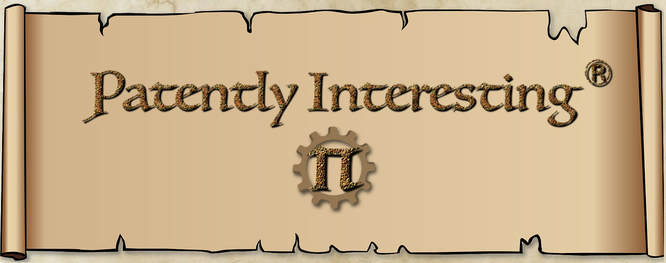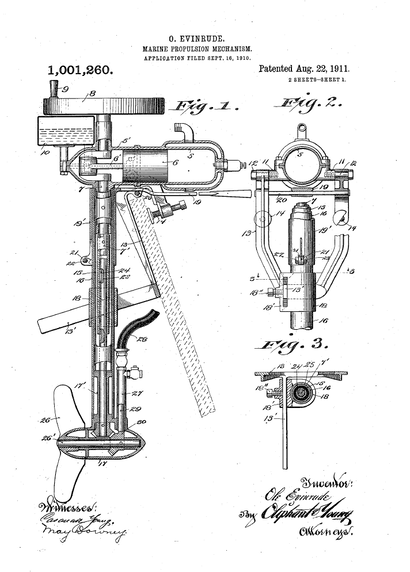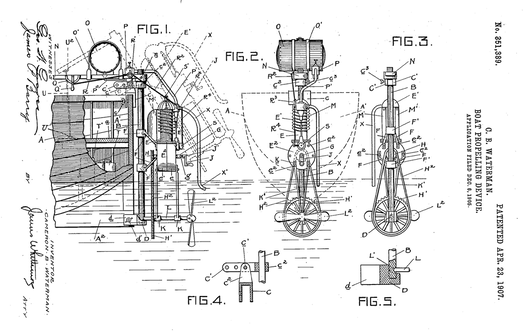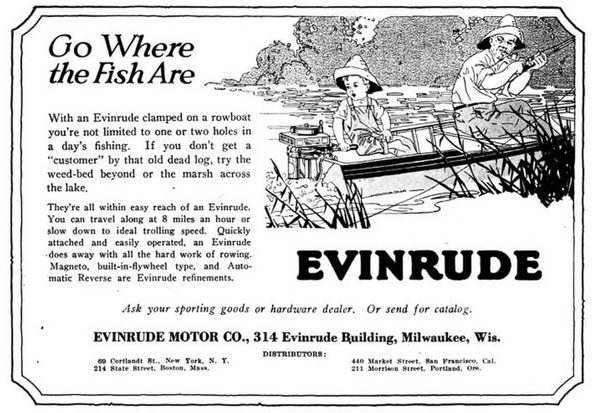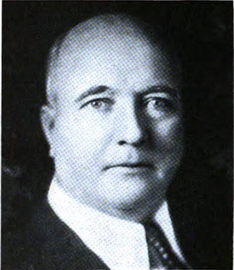 Ole Evinrude
Ole Evinrude
On September 16 of the year 1910, Ole Evinrude filed a patent application for a "Marine Propulsion Mechanism", which would issue in 1911 as U.S. Patent No.: 1,001,260. The Marine Propulsion Mechanism was a gasoline-powered outboard motor for removable attachment to a small boat, such as a row boat or a canoe. While Evinrude did not invent the outboard motor, his design was superior to those of his predecessors and made Evinrude's outboard motor commercially successful. Indeed, it can be said that Evinrude established the outboard motor industry.
In the late 1890's, early experimenters, such as Harry Miller of race car fame, built and tested gasoline-powered outboard motors. These early motors, however, were mostly one-offs and were never commercially produced. It wasn't until 1906 that the first gasoline-powered outboard motor was commercially sold by Cameron Waterman, who received U.S. Patent No.: 851,389 on April 23, 1907 for his motor. As shown in the '389 patent, the Waterman motor was originally chain-driven, but was soon modified to use an open drive shaft and bevel gearing. Even with this modification, the Waterman motor was a rather ungainly affair, both in looks and operation, which earned it the nickname the "Coughing Sarah". Due to increasing competition, the Waterman motor was sold for less than twenty years. Before it slipped into obscurity though, the Waterman motor made a valuable contribution to the industry, namely the term "outboard motor". A friend of Waterman's had coined the term and Waterman used it extensively in advertising for his motor.
In the late 1890's, early experimenters, such as Harry Miller of race car fame, built and tested gasoline-powered outboard motors. These early motors, however, were mostly one-offs and were never commercially produced. It wasn't until 1906 that the first gasoline-powered outboard motor was commercially sold by Cameron Waterman, who received U.S. Patent No.: 851,389 on April 23, 1907 for his motor. As shown in the '389 patent, the Waterman motor was originally chain-driven, but was soon modified to use an open drive shaft and bevel gearing. Even with this modification, the Waterman motor was a rather ungainly affair, both in looks and operation, which earned it the nickname the "Coughing Sarah". Due to increasing competition, the Waterman motor was sold for less than twenty years. Before it slipped into obscurity though, the Waterman motor made a valuable contribution to the industry, namely the term "outboard motor". A friend of Waterman's had coined the term and Waterman used it extensively in advertising for his motor.
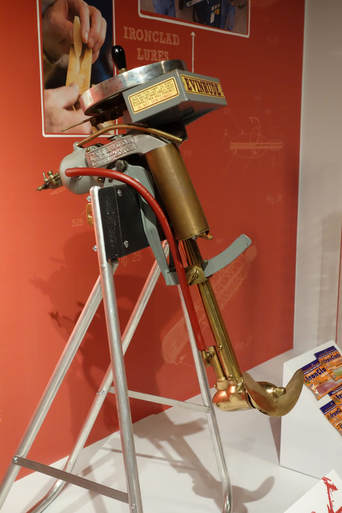 The 1909 Evinrude Motor
The 1909 Evinrude Motor
Ole Evinrude was born in Norway and immigrated to the U.S. as a young child. From a very early age, Ole displayed an aptitude for all things mechanical. He left school after the third grade and became an itinerant tradesman at the young age of 16, working in machine shops and factories in a number of different states. Eventually, Ole settled in the Milwaukee area and set about courting a young lady by the name of Bess Carey, who would later become his wife. As the story goes, it was on one of their dates that Ole got the idea for an outboard motor. Ole and Bess had rented a row boat on a lake and rowed to an offshore island for a picnic, during which Bess decided that she wanted ice cream. Not wishing to disappoint, Ole rowed back to shore and purchased some ice cream at a lakeside shop. By the time he returned to Bess, however, the ice cream had completely melted. The melted mess gave Ole the idea to speed up travel in a small boat using an outboard motor.
Whether the ice cream story is true or not is debatable; there is some evidence that Ole may actually have gotten the idea for an outboard motor from Harry Miller. Whatever the motivation, Ole began tinkering around in his workshop and built a prototype outboard motor that he first tested in 1907. In that same year, he founded the Evinrude Motor Co. in Milwaukee. In 1909, the firm began to sell its first commercial outboard motor, which had a single cylinder and only produced 1.5 hp. Nonetheless, the motor was an instant success.
The success of the Evinrude motor was due its reliability, sleek design and innovative features. The innovative features are disclosed in the '260 patent, which Ole filed for a year after he started to sell his motors. The '260 patent protected two of these features: a swing frame and an extensible engine shaft. Both of these features faciliated the use of the Evinrude motor on different types of boats. The swing frame had a clamping portion for attaching the motor to a stern of a boat and an arm portion that was slidably connected to a support tube for the engine shaft. This arrangement permitted the engine shaft and the propeller to be pivoted in the longitudinal direction of the boat relative to the clamping portion. In this manner, the motor could could be mounted to a boat having a non-vertical stern. The extensible motor shaft permitted the propeller to be located at the proper water depth for any type of stern configuration.
One distinguishing feature of the Evinrude motor that was shown in (but was not protected by) the '260 patent, was the exposed flywheel that was prominently located on top of the motor. A wooden handle was attached to the flywheel to facilitate hand cranking the motor for starting purposes. The flywheel and handle earned the Evinrude motor the nickname the "knuckle buster" as a painful acknowledgement of what would happen if an operator was carelesss in starting the motor.
Together, Ole and Bess made the Evinrude Motor Co. a success, with Ole having the mechanical aptitude and Bess having the business acumen. Although it has gone through a number of permutations, the Evinrude Motor Co. is still in business today as Evinrude Outboard Motors, which is a subsidiary of BRP, Inc. (Bombardier Recreational Products).
Whether the ice cream story is true or not is debatable; there is some evidence that Ole may actually have gotten the idea for an outboard motor from Harry Miller. Whatever the motivation, Ole began tinkering around in his workshop and built a prototype outboard motor that he first tested in 1907. In that same year, he founded the Evinrude Motor Co. in Milwaukee. In 1909, the firm began to sell its first commercial outboard motor, which had a single cylinder and only produced 1.5 hp. Nonetheless, the motor was an instant success.
The success of the Evinrude motor was due its reliability, sleek design and innovative features. The innovative features are disclosed in the '260 patent, which Ole filed for a year after he started to sell his motors. The '260 patent protected two of these features: a swing frame and an extensible engine shaft. Both of these features faciliated the use of the Evinrude motor on different types of boats. The swing frame had a clamping portion for attaching the motor to a stern of a boat and an arm portion that was slidably connected to a support tube for the engine shaft. This arrangement permitted the engine shaft and the propeller to be pivoted in the longitudinal direction of the boat relative to the clamping portion. In this manner, the motor could could be mounted to a boat having a non-vertical stern. The extensible motor shaft permitted the propeller to be located at the proper water depth for any type of stern configuration.
One distinguishing feature of the Evinrude motor that was shown in (but was not protected by) the '260 patent, was the exposed flywheel that was prominently located on top of the motor. A wooden handle was attached to the flywheel to facilitate hand cranking the motor for starting purposes. The flywheel and handle earned the Evinrude motor the nickname the "knuckle buster" as a painful acknowledgement of what would happen if an operator was carelesss in starting the motor.
Together, Ole and Bess made the Evinrude Motor Co. a success, with Ole having the mechanical aptitude and Bess having the business acumen. Although it has gone through a number of permutations, the Evinrude Motor Co. is still in business today as Evinrude Outboard Motors, which is a subsidiary of BRP, Inc. (Bombardier Recreational Products).

